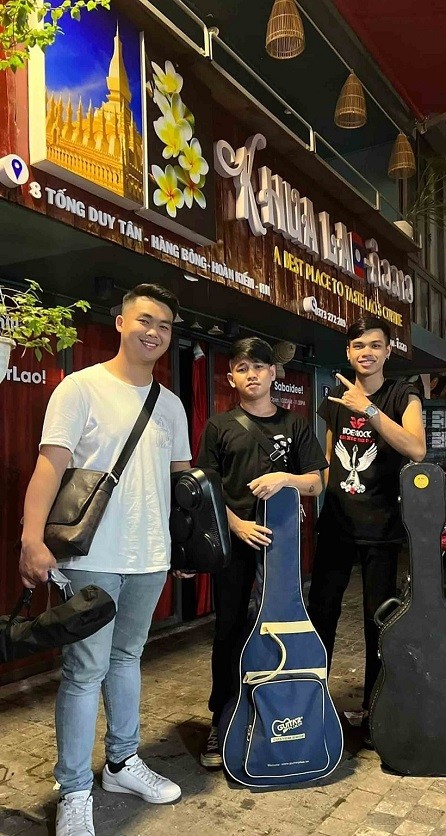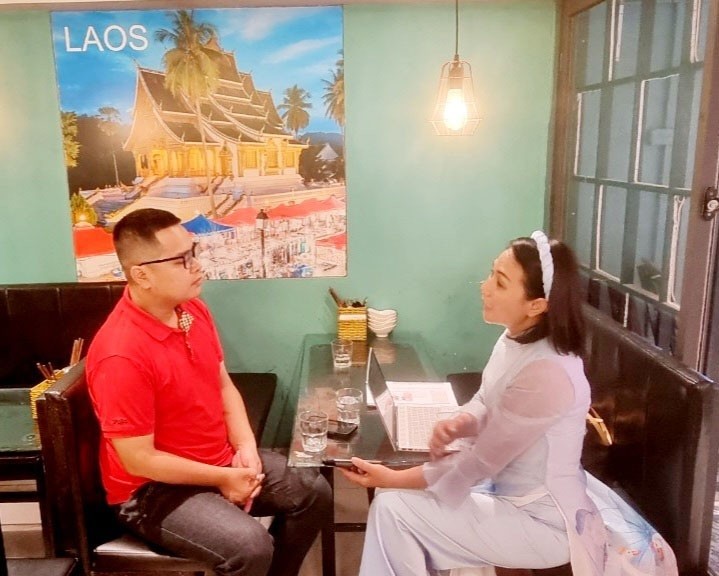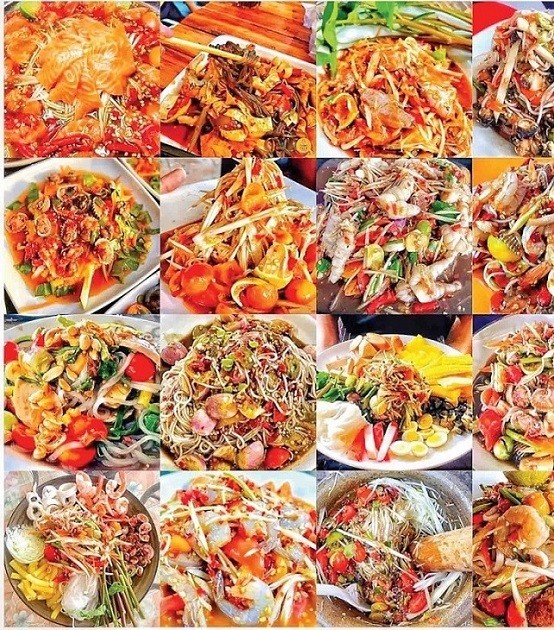
Lao Cuisine at Khua Lao
Latest
 |
| Musicians in the music band at Khua Lao. (Photo by Hoang Phuc) |
Coming to Tong Duy Tan food street (Hanoi), you will immediately recognize Khua Lao restaurant because of its unique style. With the traditional yellow-brown color as the main theme, the restaurant impressively recreates the image of the golden temple That Luang on the façade next to the Khua Lao signboard that stands out among the sparkling petals of Champa – the national flower of Laos.
A place imbued with Lao culture
Strolling in the space imbued with Lao cultural identity, I enjoyed both a tenor voice and a bass’s part-singing. Only those with a wide vocal range are able to express that piece of music so completely.
When the song finished, I approached the singers and was amazed to know that both of them were Laotians. If we don’t listen carefully, it is impossible to realize that they’re foreigners because their pronunciation, voice and singing techniques adhere to Vietnamese standards. I told them that in Vietnam, very few male singers choose to sing this song, which is mostly sung by female singers. Therefore, I was very surprised and thrilled when listening to Lao male singers singing this song.
Leaving the microphone on the stage, one of the two young men approached me, extended his hand and introduced himself: “I am a grudging singer cum owner of Khua Lao. My name is Phoumphithath Oupaseuth, and my Vietnamese name is Hoang Duy Phuc. Just call me Phuc.” Turning to his duet, he said: “This is the true singer – named Poukky. In charge of two guitars, a bass, and a soloist are Saly and Koung, and the skilled drummer is Babbo. The owner’s genuinely Vietnamese style of talking and enthusiasm make me feel at home.
Seeing that there was an empty seat beside me, a Western European guest sat next to me and asked to borrow the menu. I gave it to him and also introduced a few dishes such as Italian pasta and vegetable salad, but he thanked me and said “I like larb” (a typical traditional dish of Laos). Before I could be surprised, he immediately said: “I have just traveled to Laos for two weeks and was very impressed with larb. I will visit Vietnam for two weeks, then Cambodia and back to Sweden.”
The Laotian band plays music at Khua Lao every Friday and Saturday night. Phuc said that he wanted people to listen to Lao songs and eat Lao dishes to relieve homesickness.
Everyone who has come here feels happy and comfortable. It is displayed in the cheerful faces and pleasant conversations. The owner is of the opinion that those who enter the restaurant are family members and will be well served by Khua Lao – a Laotian kitchen.
 |
| The author is talking with Khua Lao restaurant owner Phoumphithath Oupaseuth (Vietnamese name Hoang Duy Phuc). (Photo by Nguyen Cuong) |
Khua Lao has become a rendezvous for lovers of Lao culture and a place of love when many couples got acquainted here and then became husband and wife. There are Lao-Vietnamese families who go to the restaurant every week. Phuc’s wife is also Vietnamese – a teacher who is very good at Lao language but now has to take a break from teaching to manage Khua Lao restaurant in Lang Chua and take care of their young children.
Thanks to Khua Lao, Phuc has got many friends from Vietnam, Laos and Cambodia working and living in Hanoi. Sometimes he works as an interpreter in Lao-Vietnamese diplomatic events. International partners related to Laos in Hanoi also often come to Khua Lao to meet up and discuss work. Phuc shared: “I feel very proud that Khua Lao has contributed to promoting my homeland’s culture in the heart of Hanoi”.
Lao cuisine specialties
Invited by Phuc to see over the restaurant’s kitchen area, I learned that the restaurant has three chefs. An elderly chef – the main chef – is in charge of traditional dishes. Because the people who come here are usually Lao people studying and working in Vietnam, or Vietnamese people in Laos returning home, they want to enjoy memorable dishes such as larb, sticky rice, and fish soups.
 |
| The salad dishes of Khua Lao restaurant. (Photo by Hoang Phuc) |
A younger chef is in charge of making new Lao dishes such as rice sets and barbecue. Every year, about 1,500 Lao international students come to Vietnam. Most of them like new and quick dishes and only occasionally choose traditional dishes. The remaining chef takes charge of promoting the “typical dishes” – Laos’ 40 salad dishes. If he has time, the owner will also roll up his sleeves to participate in the making of these typical salad dishes.
Currently, Khua Lao has two branches at Chua Lang and Tong Duy Tan streets. At Chua Lang, the diners are mainly Laotian students, so the main menu is 40 salad dishes. After a period of effective operation, Phuc and his wife decided to open another restaurant at Tong Duy Tan, with a more elaborate arrangement and a richer menu.
As a food lover, Phuc initially made Lao dishes and sold them online. Encouraged by other people, he then decided to open a restaurant and therefore received unexpectedly warm welcome. The number of diners coming to his Lao kitchen in Chua Lang gradually increased. Gaining momentum, Phuc took another step forward with the desire to open a Lao restaurant in Tong Duy Tan food street so that every Laotian who comes to Vietnam can see it.
Finding a restaurant for rent in Tong Duy Tan is difficult, and the rental price is even more challenging. However, thanks to their determination, Phuc and his wife finally found a suitable place to open a second outlet.
The menu here is more diverse, meeting the requirements of even the most demanding Lao – Vietnamese diners. Besides, Phuc is very concerned about the taste of customers in different regions of Vietnam. For example, Southern customers have quite similar tastes to Laotians – preferring rich and sweet flavors. Customers from Central Vietnam prefer a bit more salty food, while customers from the North prefer lighter food.
“I see that even though our restaurant is in the North, a lot of people from the South come. That’s because there are many tourists from the South to the North, and they often go to the food street and eat out at night,” he said.
The owner of the shop Khua Lao thoughtfully recalled: “I have come to work and live in Vietnam for eight years now and married a girl from Da Lat. Both of us are lecturers. Because of the Covid-19 pandemic, we turned to Laotian food business and fortunately have done quite well.” Currently, the work related to administrative procedures is taken care of by his wife and the kind landlady, and standard Lao ingredients are in charge by his two close friends in Son La. Therefore, Phuc is somewhat reassured when he thinks of a third facility for Khua Lao.
The later in the evening, the more crowded the food street becomes. Under the influence of Lao beer, we sang together:
"Hà Nội-Vientiane bút rạ cao bay (Lao language)
The sound of the gourd zither resounds with the sound of the pan flute
Our bond is strong
For so many years, still beautiful and charming
Brighter than the full moon."
That night, though not speaking out loud, in our hearts we all felt that the moon seemed to be brighter than the super moon the day before.

















